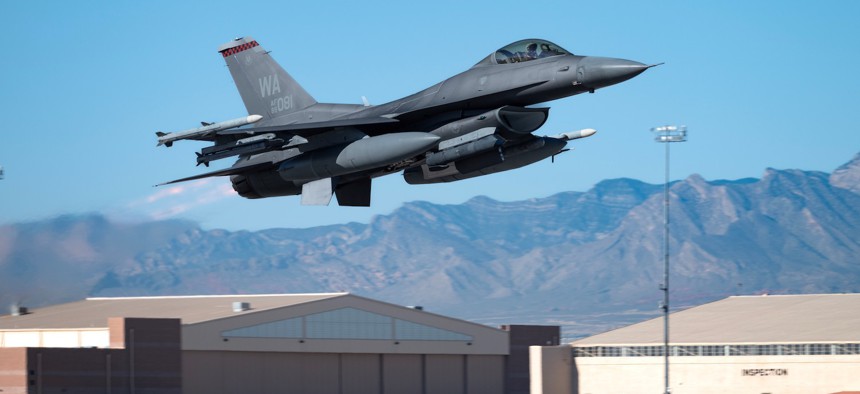
An F-16 Fighting Falcon assigned to the 16th Weapons Squadron, U.S. Air Force Weapons School, takes off for a training mission over the Nevada Test and Training Range (NTTR) from Nellis Air Force Base, Nevada, Nov. 1, 2023. U.S. Air Force / 1st Lt. Jimmy Cummings
L3Harris eyes 2025 for F-16 EW production
Viper Shield will enable international customers to detect more than one enemy.
DUBAI, UAE—An upgraded electronic warfare suite that will give F-16 fighter jets the ability to detect multiple enemies at once should be ready for production in late 2025.
L3Harris is building “Viper Shield,” a fully digital radar warning receiver that detects the radio emissions of an adversary, for international customers of Lockheed Martin’s F-16 Block 70/72 jets.
“It eliminates analog performance issues, like only detecting one signal at a time, and its digital architecture can detect multiple signals at the same time, which with the analog version was not possible,” said Anna Gragossian, the company’s director of business development for electronic warfare.
L3Harris is contracted to build 166 Viper Shield systems for new Block 70/72 aircraft for “five international customers,” Gragossian said.
The system was “designed to identify modern radar systems, provide situational awareness, and provide self-protection through electronic countermeasures. It has a digital receiver and transmit channels that are well equipped to defeat the modern threats,” she said.
The program is on track to complete its next milestone, called “drop 3,” next month. Once complete, the system will be able to demonstrate an initial radar warning receiver capability “with production-representative hardware,” Gragossian said.
As L3Harris puts the final touches on the Viper Shield upgrade, Lockheed is trying to ramp up F-16 production, under pressure from Congress to speed up deliveries of the jets to Taiwan.
Lockheed is upgrading Taiwan’s current fleet of 139 F-16s with Viper Shield and Northrop Grumman’s active electronically scanned array radar as the island waits for its new F-16s.
The new electronic warfare suite was designed to integrate with the Northrop-made AESA radar, Gragossian said.
L3Harris is already working with Lockheed to support Taiwan’s planned upgrades, Gragossian said: “We are on contract [with] Lockheed and how the U.S. government decides to allocate aircraft is done by the U.S. government, so we adhere to the contract that we have.”
As Lockheed increases F-16 production, Gragossian said L3Harris will “build up” to producing eight Viper Shield systems per month.
Lockheed delivered the first of its new Block 70 fighter jets to Bahrain in March. However, new F-16s coming off the production line don’t have the new electronic warfare suite because the company was contracted for Viper Shield after the Block 70 program was started.
“Anything that gets delivered without Viper Shield, we will have to get Viper Shield after. But that's not because we were late. We were put on contract two years later than when the program started,” she said.
The company is focused on the F-16 program, but Gragossian said they’re also eyeing other programs for the new EW suite. “We are looking at other fighters, other platforms, wherever possible,” she said.


